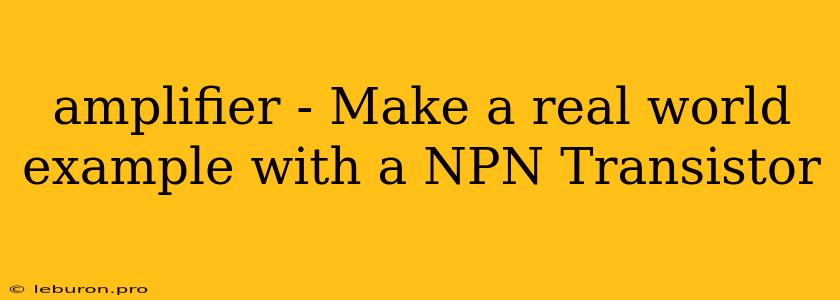Understanding Amplifiers: A Real-World Example with an NPN Transistor
Amplifiers are fundamental components in countless electronic systems, from our smartphones and TVs to complex industrial equipment. Their primary function is to boost the strength of a signal, allowing it to travel further, drive larger loads, or simply be processed more effectively. One of the simplest and most common amplifier circuits utilizes an NPN transistor, a three-terminal semiconductor device that acts like a controlled switch. This article will explore the workings of a basic NPN transistor amplifier circuit and delve into a practical example illustrating its real-world application.
The NPN Transistor: A Controlled Switch
At its core, an NPN transistor acts as a variable resistor, its resistance controlled by the current flowing through its base terminal. The three terminals of an NPN transistor are:
- Emitter (E): This terminal emits electrons, forming the primary current flow.
- Base (B): A small current injected into the base controls the flow of a larger current between the collector and emitter.
- Collector (C): This terminal collects the majority of the emitter current, which is amplified by the base current.
How it Works
Imagine the NPN transistor as a water valve. The emitter is like the water source, the collector is the pipe where the water flows out, and the base is the valve that controls the flow. A small amount of current (water) at the base can control a much larger current (water flow) between the collector and emitter.
This amplification happens because the base current attracts a much larger number of electrons from the emitter to the collector. The base current acts as a control mechanism, allowing even a small change in base current to significantly influence the current flowing between the collector and emitter.
A Practical Example: Audio Amplifier
A common application of NPN transistors is in audio amplifiers. In these circuits, the NPN transistor amplifies the weak audio signal from a source, like a microphone or a guitar pickup, making it powerful enough to drive speakers.
The Circuit
A basic audio amplifier using an NPN transistor typically consists of the following components:
- NPN Transistor: The heart of the amplifier, responsible for amplifying the signal.
- Input Resistor (R1): Limits the current flowing into the base of the transistor.
- Coupling Capacitor (C1): Blocks any DC component in the input signal while passing the AC audio signal.
- Output Resistor (R2): Determines the output impedance of the amplifier.
- Load Resistor (RL): Represents the speaker or other load the amplifier will drive.
How it Works
- Input Signal: The audio signal from a source (e.g., microphone) is applied to the input resistor (R1).
- Base Current: A small portion of the input signal current flows through the base resistor (R1) and into the base of the transistor.
- Amplification: The small base current controls a much larger current flow between the collector and emitter. This amplified current flows through the load resistor (RL), which is the speaker.
- Output Signal: The amplified current flowing through the load resistor creates a stronger, audible output signal.
Note: This is a simplified explanation. Real-world audio amplifier circuits often use multiple transistors and additional components to achieve higher fidelity and power levels.
Advantages of NPN Transistor Amplifiers
- Simplicity: NPN transistor amplifiers are relatively easy to design and build.
- Low Cost: NPN transistors are inexpensive and readily available.
- Versatility: NPN transistors can be used in various applications, including audio amplifiers, power amplifiers, and switching circuits.
Conclusion
NPN transistors are a cornerstone of electronics, enabling the amplification of signals and power in countless applications. Understanding their basic operation and how they act as controlled switches helps demystify their role in creating real-world devices. From simple audio amplifiers to more complex circuitry, NPN transistors continue to play a crucial role in shaping the world of electronics.
